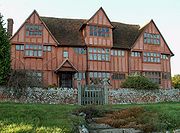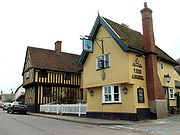
Glemsford
Encyclopedia
Glemsford is a village in the Babergh
district in Suffolk
, England
, near the town of Sudbury
. Glemsford is located near the River Glem and the River Stour
also flows nearby. Glemsford is surrounded by arable
farmland and is not far from historic Suffolk villages such as Lavenham
and Long Melford
.
 The village dates back to the Domesday Book
The village dates back to the Domesday Book
in 1086, in which Glemsford was recorded. The village has noteworthy features such as Monks Hall, which is a medieval timber structure. It is said that a tunnel once connected Monks Hall to the nearby Parish Church of St Mary the Virgin, which the monks formerly used to access the church instead of mixing with the ordinary villagers. Only a small part of this tunnel remains. The Parish Church of St Mary the Virgin dates back to the early 14th century, with the earliest recorded rector being Hugh de Poynton in 1302. The church features the Golding Chapel, built in memory of the rich Glemsford cloth merchant, John Golding. Golding lived in the Angel House, another timber building adjacent to The Angel public house. Golding left money for the chapel to be built when he died, likewise as with other parish churches St Mary's Church tower was rebuilt in the 19th century. Monks Hall itself has gone through changes of use and appearance through the centuries and is now a private residence. Glemsford Methodist Church is situated at the other end of the village and dates from the Victorian era
.
In the early 16th century, Glemsford became the home of George Cavendish who was a local nobleman and gentleman-usher to Cardinal Thomas Wolsey. Upon Wolsey's death in 1530, Cavendish retired to Glemsford and in the mid-1550s he finalized a biography on Cardinal Wolsey which was published after his own death in 1562.
The village and the surrounding area, like much of East Anglia
, was a strongly Puritan
during much of the 17th century. By 1640, several families had departed for the Massachusetts Bay Colony
as part of the wave of emigration that occurred during the Great Migration
.
Glemsford railway station
was on the route between Sudbury and Cambridge
, known as the Stour Valley Railway. The station opened in the 1860s and saw its busiest period during the First and Second World Wars when it, along with nearby Cavendish station
, was bombed. This was because Glemsford station was one of the places which harboured ammunition trains. The station was closed during the Beeching Axe
in 1967; only the Station House (now private), goods shed (now converted to flats) and one level crossing post remain.
 Glemsford is a large and rather industrial village by Suffolk standards; it also has a considerable number of shops and public houses. Among the public houses are The Black Lion, a Medieval timber building, The Angel and The Cock Inn.
Glemsford is a large and rather industrial village by Suffolk standards; it also has a considerable number of shops and public houses. Among the public houses are The Black Lion, a Medieval timber building, The Angel and The Cock Inn.
Babergh
Babergh is a local government district in Suffolk, England. Its council headquarters is based in Hadleigh, whilst its largest town is Sudbury.The district was formed on 1 April 1974 by the merger of the Borough of Sudbury, Hadleigh urban district, Cosford Rural District, Melford Rural District and...
district in Suffolk
Suffolk
Suffolk is a non-metropolitan county of historic origin in East Anglia, England. It has borders with Norfolk to the north, Cambridgeshire to the west and Essex to the south. The North Sea lies to the east...
, England
England
England is a country that is part of the United Kingdom. It shares land borders with Scotland to the north and Wales to the west; the Irish Sea is to the north west, the Celtic Sea to the south west, with the North Sea to the east and the English Channel to the south separating it from continental...
, near the town of Sudbury
Sudbury, Suffolk
Sudbury is a small, ancient market town in the county of Suffolk, England, on the River Stour, from Colchester and from London.-Early history:...
. Glemsford is located near the River Glem and the River Stour
River Stour, Suffolk
The River Stour is a river in East Anglia, England. It is 76 km long and forms most of the county boundary between Suffolk to the north, and Essex to the south. It rises in eastern Cambridgeshire, passes to the east of Haverhill, through Cavendish, Sudbury and the Dedham Vale, and joins the...
also flows nearby. Glemsford is surrounded by arable
Arable land
In geography and agriculture, arable land is land that can be used for growing crops. It includes all land under temporary crops , temporary meadows for mowing or pasture, land under market and kitchen gardens and land temporarily fallow...
farmland and is not far from historic Suffolk villages such as Lavenham
Lavenham
Lavenham is a village and civil parish in Suffolk, England. It is noted for its 15th century church, half-timbered medieval cottages and circular walk. In the medieval period it was among the 20 wealthiest settlements in England...
and Long Melford
Long Melford
Long Melford is a large village and civil parish in the county of Suffolk, England. It is on Suffolk's border with Essex, which is marked by the River Stour, approximately from Colchester and from Bury St. Edmunds...
.
History

Domesday Book
Domesday Book , now held at The National Archives, Kew, Richmond upon Thames in South West London, is the record of the great survey of much of England and parts of Wales completed in 1086...
in 1086, in which Glemsford was recorded. The village has noteworthy features such as Monks Hall, which is a medieval timber structure. It is said that a tunnel once connected Monks Hall to the nearby Parish Church of St Mary the Virgin, which the monks formerly used to access the church instead of mixing with the ordinary villagers. Only a small part of this tunnel remains. The Parish Church of St Mary the Virgin dates back to the early 14th century, with the earliest recorded rector being Hugh de Poynton in 1302. The church features the Golding Chapel, built in memory of the rich Glemsford cloth merchant, John Golding. Golding lived in the Angel House, another timber building adjacent to The Angel public house. Golding left money for the chapel to be built when he died, likewise as with other parish churches St Mary's Church tower was rebuilt in the 19th century. Monks Hall itself has gone through changes of use and appearance through the centuries and is now a private residence. Glemsford Methodist Church is situated at the other end of the village and dates from the Victorian era
Victorian era
The Victorian era of British history was the period of Queen Victoria's reign from 20 June 1837 until her death on 22 January 1901. It was a long period of peace, prosperity, refined sensibilities and national self-confidence...
.
In the early 16th century, Glemsford became the home of George Cavendish who was a local nobleman and gentleman-usher to Cardinal Thomas Wolsey. Upon Wolsey's death in 1530, Cavendish retired to Glemsford and in the mid-1550s he finalized a biography on Cardinal Wolsey which was published after his own death in 1562.
The village and the surrounding area, like much of East Anglia
East Anglia
East Anglia is a traditional name for a region of eastern England, named after an ancient Anglo-Saxon kingdom, the Kingdom of the East Angles. The Angles took their name from their homeland Angeln, in northern Germany. East Anglia initially consisted of Norfolk and Suffolk, but upon the marriage of...
, was a strongly Puritan
Puritan
The Puritans were a significant grouping of English Protestants in the 16th and 17th centuries. Puritanism in this sense was founded by some Marian exiles from the clergy shortly after the accession of Elizabeth I of England in 1558, as an activist movement within the Church of England...
during much of the 17th century. By 1640, several families had departed for the Massachusetts Bay Colony
Massachusetts Bay Colony
The Massachusetts Bay Colony was an English settlement on the east coast of North America in the 17th century, in New England, situated around the present-day cities of Salem and Boston. The territory administered by the colony included much of present-day central New England, including portions...
as part of the wave of emigration that occurred during the Great Migration
Great Migration (Puritan)
The Puritan migration to New England was marked in its effects in the two decades from 1620 to 1640, after which it declined sharply for a while. The term Great Migration usually refers to the migration in this period of English settlers, primarily Puritans to Massachusetts and the warm islands of...
.
Glemsford railway station
Glemsford railway station
Glemsford railway station was a station in Glemsford, Suffolk.-External links:*...
was on the route between Sudbury and Cambridge
Cambridge
The city of Cambridge is a university town and the administrative centre of the county of Cambridgeshire, England. It lies in East Anglia about north of London. Cambridge is at the heart of the high-technology centre known as Silicon Fen – a play on Silicon Valley and the fens surrounding the...
, known as the Stour Valley Railway. The station opened in the 1860s and saw its busiest period during the First and Second World Wars when it, along with nearby Cavendish station
Cavendish railway station
Cavendish railway station was a station in Cavendish, Suffolk.-External links:*...
, was bombed. This was because Glemsford station was one of the places which harboured ammunition trains. The station was closed during the Beeching Axe
Beeching Axe
The Beeching Axe or the Beeching Cuts are informal names for the British Government's attempt in the 1960s to reduce the cost of running British Railways, the nationalised railway system in the United Kingdom. The name is that of the main author of The Reshaping of British Railways, Dr Richard...
in 1967; only the Station House (now private), goods shed (now converted to flats) and one level crossing post remain.

External links
- Glemsford Parish Council website
- www.glemsford.org.uk
- A Short History of Glemsford Rev Kenneth W. Glass, former Rector of St. Mary the Virgin, Glemsford.

